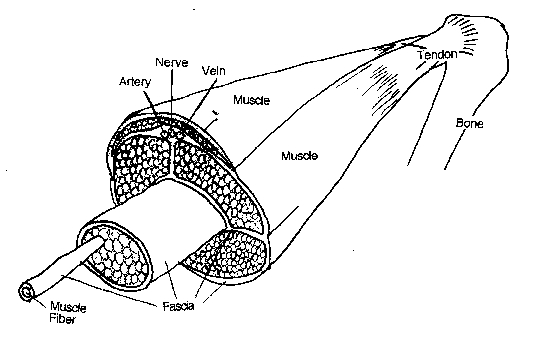Fascia
Fascia is a form of connective tissue. Its job is to provide a sliding and gliding environment for muscles, to suspend organs in their proper place, to transmit movement from muscle to the bones they are attached to, and to provide a supportive and moveable wrapping for nerves and blood vessels as they pass through and between muscles.
Fascia, in its non-stretchy form, is the substance that makes up tendons, which attach muscle to bone, and ligaments, which attach bone to bone.
Muscles are composed of muscle fibers that are each wrapped in a thin, tight sheath of connective tissue known as fascia. Bundles of muscle fibers are then over wrapped with a slightly thicker layer of fascia, then bundles of bundles are similarly wrapped with fascia and then the total muscle is wrapped again with another layer of fascia. As the muscle nears its end at a bone, the size and number of muscle fibers significantly decreases, narrowing the circumference of the muscle, but the fascia that has been wrapping those muscle fibers continues, becoming the tendon that attaches the muscle to bone. Fascia is like a big cobweb that runs throughout your entire body. The interconnected nature of fascia means that everything in the body is connected to everything else. When one part of fascia is injured or compromised in any way, it can affect tissues that are far from the original site of the injury or impairment. In the case of repetitive strain injuries, this means that tissue changes in the shoulder which are the result of an old injury can, over time, affect the condition and function of fascia farther down the arm and into the hand. This often leads to the confusing, seemingly unrelated symptoms that are often present in any case of RSI. Symptoms may be felt in one area, but the source of the strain could be located somewhere else. When poor posture habits cause fascial changes in the neighborhood around a nerve, then the normally loose, suspending fascia that protects that nerve becomes tighter. The nerve, inside its casing of tight fascia, can then become stuck to nearby muscle, bone, blood vessels, or even skin. Every time muscles in the area contract, the tight casing of fascia around the nerve gets tugged and the nerve becomes more and more irritated until an injury is felt, causing tingling, numbness, zinging sensations, and sometimes burning or weakness. In the case of repetitive strain injuries that have muscle-based symptoms (weakness, pain, pressure, drawing sensations, congestion, etc.), the fascia surrounding and permeating through muscle becomes tight and restricted. This can prevent the muscle from accomplishing the work it is designed to do by inhibiting the full contraction and release of the tight muscle. This forces neighboring muscles to pick up the slack, helping the restricted muscle do its job. The problem is, the helper muscles aren’t designed to contract and release in exactly the same direction as the restricted muscle, so helping causes more strain in the helper muscle. Now you have two muscles that are restricted and strained and the process of more adhesion and more restriction continues. Fascia creates a wrapping around the entire muscle, much like a sausage casing. This part of the fascia can also become adhered and will cause one muscle to stick to its neighbor. When one muscle contracts, it must drag along the muscle that is stuck to it, causing strain. Fascia tightens in the area to help protect the strained muscles, and more adhesions develop as a result. Fascia molds itself over time according to how the body is used. Here’s a simple example of what I mean: Cross your arms over your chest and notice which arm ends up on top. Now, cross them the other way, with the other arm on top. Notice how funny this feels, how you are unused to crossing your arms in this way and how unnatural it feels to do so. This is because you have repeated your favorite way of crossing your arms thousands of times throughout your life and the fascia in your arms has been molded according to that pattern. The same thing occurs in any area of the body that is used in a repetitive way. The moldability of fascia is the reason that ergonomics is so important when recovering from a repetitive strain injury. If a person habitually sits in a slouched posture, then over time the fascia in their body will mold itself to that posture. Fascia in the chest will pull the ribcage down, fascia in the neck will pull the head and neck forward, the slouched position of the upper torso will change how the arm bones fit in the shoulder joints and the fascia in the shoulder area will change as a result. All of these posture-related tissue changes will be felt by the body as a source of strain. Now, add a repetitive motion using muscles in that area and you have the perfect environment for creating a repetitive strain injury. By working to correct poor posture and by practicing good ergonomics, many sources of strain can be reduced or eliminated. The body will function more efficiently and with significantly less pain and restriction. When your mother told you to sit up straight, she was right! Click on the “Back” button on your browser’s navigation bar to return to the previous page. Or, return to the Home Page to read about other Repetitive Strain Injuries.
P.S. it is from Fascia : http://www.selfcare4rsi.com/fascia.html

沒有留言:
張貼留言